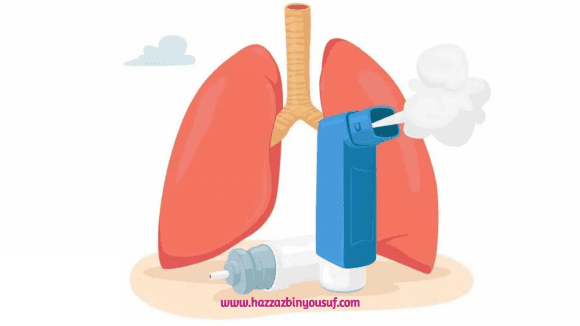
what causes asthma in adults
Asthma is a chronic disease of the respiratory system characterized by the swelling and narrowing of the airways, which can produce excess mucus. Due to this, the patient experiences difficulty in breathing, wheezing and shortness of breath. It also causes coughing.
The types of asthma are:
Asthma can be of different types based on its severity and triggers.
Types of asthma based on severity are:
1. Gentle and non-stop
2. Gentle and persistent
3. Medium and continuous
4. Severe and persistent
Based on the aggravating factor, the types of these chronic physical conditions are-
Bronchial: It is most commonly observed and affects the airways of the lungs.
Allergic : It can be due to allergies like pet dander, food, mold, flower pollen etc.
Indoor: These types of problems can be caused by cigarette smoke, viral disease germs, household cleaning products, fragrances, air pollution etc. present in the air we breathe.
Occupational: Many people are exposed to irritants such as gases, chemicals, dust or latex in the workplace atmosphere.
Nocturnal: As the name suggests, in this type of asthma, the symptoms are worse at night.
Common cold – Types: In this case the symptoms are characterized by chronic unrelenting dry cough.
Seasonal: This type occurs only at certain times of the year or under certain conditions, such as cold winds in winter or from hay pollen.
Also read: foods that strengthen bones and teeth
Causes of Asthma-
Asthma can be caused by both genetic and environmental factors. A complex interplay between these two factors is the cause of this chronic disease. Some common reasons are:
1. A person is at risk of developing it if one or both parents have asthma.
2. A long period of time has passed between viral infections in childhood can cause this disease.
3. Associations between allergens and certain substances that cause infections can cause asthma. Common indoor allergens include dust particles, animal proteins, pet dander, household cleaning chemicals, toxic fumes, mold spores, dyes, and allergens.
4. Prolonged exposure to cold and dry air can trigger this condition.
5. Exposure to strong emotions like shouting, laughing, crying etc. and extreme stress can trigger asthma.
6. It can be triggered by the presence of gas, dust or chemical fumes in the workplace.
7. Foggy environmental conditions, high humidity and severe air pollution lead to higher incidence and recurrence.
8. Smoking cigarettes and other forms of tobacco increases the risk of developing this condition.
Respiratory illnesses such as the flu and pneumonia help increase it.
9. In some cases, participation in physical activity and exercise can trigger an asthma attack.
10. Boys are more likely to develop asthma than girls in childhood.
11. However, women carry a higher risk of the disease than men in adulthood.
12. Adults and children who are obese or overweight are more likely to develop asthma.
13. Certain medications such as aspirin, beta-blockers, naproxen (Aleve), and ibuprofen (Motrin IB, Advil, others)
14. Preservatives and sulfites are added to a variety of beverages and foods such as dried fruit, shrimp, beer, processed potatoes, and wine.
15. Gastroesophageal reflux disease (GERD) is a condition in which acid from the stomach backs up into the throat.
What are the risk factors for asthma?
Despite the many identified causes of the condition, it is still unclear to researchers why some people suffer from the condition while others do not. However, some risk factors that may increase your risk of developing asthma include:
1. Family history of the condition or allergy—People with a blood relative with the condition, such as a parent or sibling.
2. Allergic conditions such as allergic rhinitis (hay fever) or atopic dermatitis.
3. Being overweight or obese.
4. Smoking and coming into contact with someone who smokes while smoking.
5. Exposure to smoke or other pollutants.
6. Exposure to occupational substances such as chemicals used in hairdressing, agriculture and industrial production.
7. Exposure to allergens.
8. Exposure to harmful chemicals.
9. Exposure to drugs such as aspirin, NSAIDs.
10. Underweight babies are more likely to develop this condition.
11. Respiratory infections.
12. the weather
13. Heavy physical exercise.
Urban population growth is associated with an increase in asthma prevalence and dysregulation.
Symptoms-
There are four primary symptoms of asthma. These are:
- Cough
- Inhalation with exhalation (a loud whistling sound due to turbulent airflow through narrowed airways).
- Shortness of breath.
- A pressing feeling in the chest.
Other symptoms of asthma are-
- A cough which increases greatly at night.
- Symptoms are usually irregular, and people can remain in the body for a long time without any symptoms.
- Common triggers for asthma symptoms include exposure to allergens (dust particles, pets, mold, cockroaches, and pollen), germs, and exercise.
- Many signs and symptoms are usually nonspecific and may be seen in other conditions.
- Symptoms that may be attributed to conditions other than asthma and may require consultation are the presence of associated symptoms (such as palpitations, chest discomfort, fatigue, and light-headedness), age-related onset of new symptoms, and lack of appropriate asthma medications.
- Increased heart rate, increased respiratory rate and effort required for breathing.
- Use accessory muscles to make breathing efforts with reduced breath sounds.
Lowering the normal oxygen levels in the human body. A low blood oxygen level is a dangerous sign that indicates respiratory failure.
the movement - Decreased lung function.
- Difficulty sleeping due to above mentioned symptoms.
The symptoms of this disease may be aggravated or aggravated by the following individuals:
- High-intensity or excessive exercise.
- Exposure to intolerable gases, chemical fumes or dust due to occupational conditions.
- Exposure to allergens like pollen, pet dander, pollen etc.
In what cases is it necessary to consult a doctor?
Most people’s asthma is not a serious or acute problem. Although there is no permanent cure for this condition, it can be easily managed with certain lifestyle changes and management that can lead to a better and healthier life. Although most people experience occasional flare-ups from minor irritants, some cases usually require an emergency visit to the doctor. Any delay in seeking emergency treatment for the following asthma symptoms can potentially be fatal:
- If you are experiencing shortness of breath, the condition is rapidly worsening.
- If using an inhaler does not provide relief.
- If you experience severe shortness of breath while performing daily activities.
Other conditions that require prompt contact with your doctor include:
- If you are an asthma patient.
- To monitor your asthma condition after diagnosis.
- If you notice your disease getting worse.
- Get your treatment reviewed.
Complications of Asthma-
Asthma is a chronic disease, and it will coexist with you. Some of the complications you will experience if you do not take proper precautions and preventive measures are:
- Sleep problems due to shortness of breath and cough.
- Missing school, college or work due to stimulants.
- Side effects due to long term use of inhalers and medicines.
How is asthma diagnosed?
Asthma diagnosis is mainly based on medical history and a thorough physical examination. People with this disease usually have a long history of allergic rhinitis, allergies, shortness of breath, cough, and difficulty breathing during exercise or lying down at night. When these conditions are relieved by medication, it is understood that the person is suffering from the said disease.
Some experimental methods help to diagnose the disease:
Spirometry: This is used to measure lung function when a person breathes into a tube. If the person’s lung function improves after using a bronchodilator such as albuterol, this confirms the diagnosis of asthma.
However, it is important to note that normal pulmonary function tests do not rule out the possibility of this condition.
Measurement of Exhaled Nitric Oxide (FeNO): This is performed by a simple breathing exercise. Increased levels of exhaled nitric oxide indicate “allergic” inflammation, similar to that seen in asthma.
Skin testing for common aeroallergens: The presence of sensitization to environmental allergens increases the likelihood of asthma. Skin testing is useful in identifying allergies to environmental substances.
Methacholine challenge test: This test detects airway hyper-responsiveness. The tendency for the airways to narrow in response to exposure to an unpleasant substance is called hyper-reactivity.
Sputum eosinophils: This is another marker of “allergic” inflammation seen in chronic conditions such as asthma.
Chest imaging: This test can show elevated inflammation and help rule out other conditions, such as a heart exam, and is also used in some cases.
Blood test: This helps to differentiate the type of asthma. Blood tests measure levels of allergic antibodies (IgE) or specialized white blood cells called eosinophils, which are associated with allergic or exothermic asthma.
Asthma treatment
As asthma cannot be cured, its treatment includes:
- Adequate symptom management.
- Reduction of proliferative factors.
- Maintain normal lung function.
- Maintain normal activities and quality of life.
- Prescribed drugs should have very few side effects.
Treatment for this condition usually includes long-term medications, first aid or quick relief, breathing exercises, and home remedies. Your doctor will determine the best treatment plan for your asthma depending on your condition, overall health, age, and aggravating factors.
Different classes of drugs are used to treat it, and they can be divided into long-term drugs and quick-relief drugs.
The most effective anti-inflammatory agent is inhaled corticosteroids (ICS) and is considered the first-line drug. ICS are highly effective in reducing the risk of asthma exacerbations. The combination of an ICS and a long-acting bronchodilator (LABA) has significant beneficial effects in improving disease control.
Medicines commonly used for this condition are:
- Short-acting bronchodilators (Albuterol) provide rapid relief and may be used in conjunction with exercise-induced symptoms.
- Inhaled steroids (budesonide, fluticasone, mometasone, beclomethasone, flunisolide, ciclesonide) are first-line anti-inflammatory therapy.
- Long-acting bronchodilators (formoterol, salmeterol, vilanterol) are added to ICS as adjunctive therapy.
- The leukotriene modifier zafirlukast, (Montelukast, Zileuton) acts as an anti-inflammatory agent.
- Anticholinergic agents (ipratropium bromide, tiotropium) may help reduce sputum production.
- Anti-IgE treatment (omalizumab) can be used in allergic type.
- Anti-IL5 treatment (mepolizumab, racelizumab) can be used in eosinophilic asthma.
- Chromones (cromolyn, nedocromil) stabilize mast cells (allergic cells) but are rarely used in clinical practice.
- Theophylline helps with bronchodilation (opens the airways) but is rarely used in clinical practice because of its adverse side-effect profile.
- Systemic steroids (prednisone, prednisolone, methylprednisolone [Solu-Medrol, Medrol, Dexamethasone) are anti-inflammatory drugs used to treat inflammation but have many side effects.
Monoclonal antibodies will become available within the next few years to treat this condition. - Immunotherapy or allergy shots reduce drug use in allergic forms of the condition.
- Medicines are usually administered by inhaler or nebulizer solution. Smoking cessation or reducing exposure to smoke is essential in treating this disease. Treatment of conditions such as allergic rhinitis and gastroesophageal reflux disease (GERD) improves symptom control. Vaccinations for influenza and pneumonia are given to prevent exacerbations.
- Although many patients with asthma are treated as outpatients, emergency departments are admitted with severe illness. These patients require supplemental oxygen, administration of systemic steroids, bronchodilators such as a nebulized solution. Patients with negative results are referred to a specialist (pulmonologist or allergist).
While some of these are for short-term use, others are long-term medications that need to be taken daily to prevent disease symptoms. These include inhaled corticosteroids, leukotriene modifiers, beta-agonists, combination inhalers and theophylline.
Quick-relief/first-aid medications are medications used to provide quick, short-term relief from asthma symptoms. They may be recommended by a doctor to be taken before exercising or doing strenuous work. These include nebulizers and rescue inhalers that go deep into your lungs to help you breathe during a flare-up. Bronchodilators help relax the tight muscles in your lungs. Anti-inflammatories help target and fight inflammation in your lungs.
Breathing exercises are very beneficial in long-term asthma control. These exercises help you send more air in and out of your lungs. Over time, breathing exercises help to increase lung capacity and combat severe symptoms of the disease.
Home Remedies: Some home remedies are effective and can help in relieving the worsening symptoms. Coffee and caffeinated tea help open airways and reduce symptoms for up to four hours. Inhaling essential oils like eucalyptus, lavender, and basil can help relieve symptoms.
Asthma Home Remedies
Many home remedies can help control this disease. Some effective remedies are:
Ginger: Cut ginger into small pieces and add to boiling water. Let it boil for five minutes. Drink it after it cools down.
Mustard Oil: Heat mustard oil with little camphor. When it gets cold, rub it on your chest.
Figs: Soak 3 figs in water overnight. Eat figs and drink water in the morning.
Garlic: Boil 3 cloves of garlic in a glass of milk and drink when cool.
Coffee: Coffee is an excellent bronchodilator.
How can you prevent asthma?
Exercise cannot be prevented. However, there are many ways to manage and prevent it from progressing to a severe, life-threatening episode. Your doctor or pulmonologist will develop a management plan for you that includes the following preventive measures:
Follow an asthma action plan: Take your prescribed medications to manage asthma attacks with the help of your doctor and healthcare team. It is a chronic illness that requires regular monitoring and treatment.
Get vaccinated for influenza and pneumonia: Vaccinations for flu and pneumonia are given to prevent factors that cause disease.
Identify and avoid triggers: A number of allergens and irritants, from pollen to air pollution, will trigger an attack.
Monitor your breathing: Home flow meters are used to measure and record peak breath flow. Coughing, shortness of breath or wheezing are recognized as warning symptoms of an attack and should be treated immediately.
Detect and treat attacks early: Detecting and treating attacks early reduces a person’s chances of having a serious attack. When your peak flow measurement drops, this is a warning of an impending attack. Take your medications as directed and immediately stop any activity that might trigger an attack. If your symptoms don’t improve, try the medical support indicated in your action plan.
Take medication as directed: If your symptoms seem to be improving, never change medication without a doctor’s advice. Take medications with you to each medical visit so the doctor can double-check the medication usage and help you take the correct medication.
Watch for increased use of quick-relief inhalers: If a person notices increased use of quick-relief inhalers like albuterol, your asthma is not under control. Your doctor will adjust the treatment.
| tags : what causes asthma in adults,what causes asthma,what causes asthma in children,what causes asthma in children,what causes asthma in adults,what causes asthma,what causes asthma to flare up,what causes asthma in babies,what causes asthma to develop,what causes asthma in older adults,what causes asthma cough,what causes asthmatic bronchitis,what causes asthma in toddlers,what causes asthma in adults,what causes asthma,what causes asthma in children,what causes asthma in children,what causes asthma in adults,what causes asthma,what causes asthma to flare up,what causes asthma in babies,what causes asthma to develop,what causes asthma in older adults,what causes asthma cough,what causes asthmatic bronchitis,what causes asthma in toddlers, |












